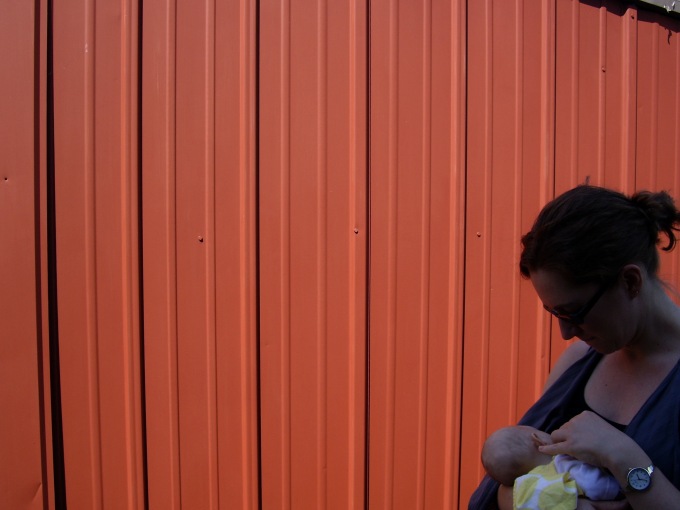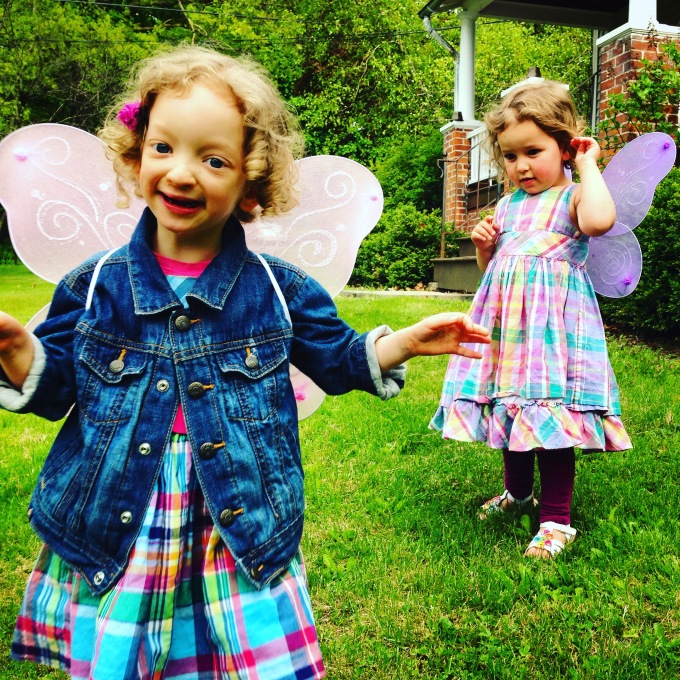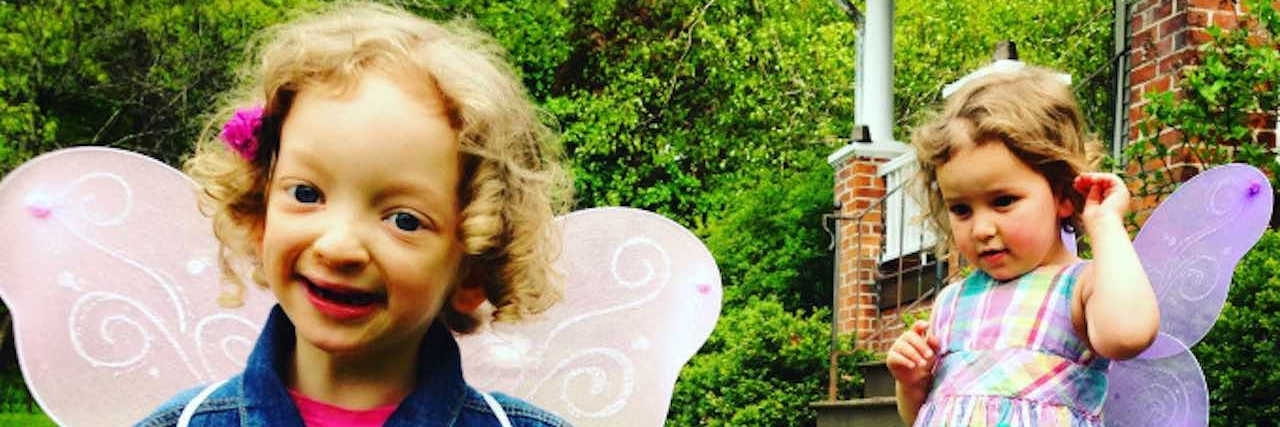Almost five years have passed since the day I labored in a hospital tub and birthed the tiny baby a midwife immediately called “Peanut.” We named that baby Fiona and we cradled her unfathomably small, 4-pound-12-ounce body. In the hospital, we learned to drop-feed her, and once home I learned to breastfeed her, and we — my husband and I —learned so much more.

We eventually learned about chromosomal deletions and meiosis. We learned about seizure variations, kidney dilation, oral stimulation and the minuscule increments in fine motor developments. We learned how to have the cheapest and most satisfying lunch at the children’s hospital (eat with the doctors in the cafeteria). We learned to stretch our daughter’s pronating feet, and we learned the best shoes to accommodate orthotics (Converse). We learned a few dozen ASL signs, and I personally learned the pros and cons of different communication apps, and I learned you never, ever pay a medical bill without first calling the doctor’s office and checking that they billed correctly. I learned to do a million things I don’t even know I know.
Today I realized one of those one million things. I realized it while having a conversation with Fiona’s grandfather, who was visiting from out of town. My father-in-law hasn’t seen Fiona in a few weeks, and he was not only amazed at the amount of food my 20-pound girl eats, as she shoveled a standard American breakfast of eggs and sausage into her mouth.
He was also amazed at her burgeoning speech.
“She’s really talking,” he said.
It’s true. Lately Fiona’s been doing what speech therapists call “approximating,” where her mouth tries its best at words, and she often gets close.
Bye bye is “guy guy.”
Hungry is “hahee.”
Potty is “ky-ee.”
Momma is “momma.” (I win.)
My father-in-law was understandably excited.
I agreed with him. She was “talking” more. “But,” I added, “there’s a lot of consonants she still can’t say.” She only has B, H, C, G and M at her disposal. I thought of the many instances when I have no idea what my girl’s saying. “Emma” is how she says Elmo, but it’s also how she says Elsa, Anna and someone she knows named Emma. On plenty of occasions, I look at Fiona clueless. In these moments, I pull her talker closer and wait. The sound in her mouth — “cah,” for instance — becomes a clear word in her talker’s electronic voice: coat, or towel, or bath.
My father-in-law — an optimist, a cheerleader, a champion of his granddaughter — offered this reply: “It won’t be long.” He thinks she’ll master more than B, H, C, G and M.
But I simply said, “We’ll see.” I couldn’t join him in his certainty. And this is when I realized one of the most important approaches I’ve taken in parenting Fiona. It’s a lesson that’s dear to me because it keeps me sane. I’ve learned to be wary of goal-setting.
If you have a background in teaching like me, you might hear a record skip. “Wait, what? Wary of goals? But goals drive instruction! Goals are like destinations on a road-trip, telling us where we’re headed! Goals articulate expectations, and if we don’t have any, then won’t we end up nowhere, or at the very least, only a block from where we started, kicking dirt beside a gas station, doing a serious disservice to our kids?”
I’m not anti-goal for Fiona. I want her teachers and therapists to have giant goals for her. I want them to see her and say, “Yes, she will walk, run, ride a tricycle, write her name, read a story, do mathematic calculations, create complex sentences with her talker…” etc.
It’s just that as Fiona’s mother, I can’t hold expectations over her. I don’t mean my “can’t” to be a moral one, as in I “shouldn’t” or “mustn’t.” I don’t mean in any way to tell you what you should do. I simply mean I can’t. I can’t say things like, “We want her walking by the summer” or “We aim for her to say ‘Dadda’ by June.”
I learned this lesson in the first year of parenting Fiona. We lived in Ohio then, and the state’s model for early intervention therapy was different than in Vermont. In Ohio the therapists came into our home purely as consultants. And because I worked fewer hours than my husband, I was the one to meet with the therapists, which meant they became consultants to me.

They were in my living room to teach me how to be Fiona’s therapist. They got down on the floor with me and together we examined Fiona’s supine body and they gave me instructions on how to play with my daughter. They said they weren’t supposed to touch my kid too much. They said I was supposed to do most of the work. They showed me how to do various renditions of tummy time, how to move a toy across her line of sight to improve her tracking and how to rig a toy to encourage her kicking.
Frankly, I can’t remember all the things they told me to do because what I mostly remember from their visits is this: they left me with a handwritten list of therapeutic tasks I should do that week, and they sometimes left me in tears. I keenly remember one visit when, after a therapist shut the front door of our house, I walked to the dining room, pressed my back against a wall, and slid down in defeat, sobbing. I wanted to be a mother, not a therapist. I didn’t want the pressure to turn my kid into something other than who she was.
The whole endeavor felt counterintuitive to what I, a newbie parent, sensed was the primary job of parenting: to love one’s kid. Just as she is. Crawling or not crawling. Grasping toys or not gasping toys. Holding her own head up or not holding her own head up. Just love her. Every typical parent gets to do it. A typical parent gets to love their kid into every developmental stage without worry, without fret, without weekly “intervention” appointments because a typical kid’s development unfolds as naturally as the two new leaves are unfurling on my Bird of Paradise. There it is: sitting unassisted. There it is: making babble sounds. There it is: the first word. All as natural as seasons. With no extra work on a parent’s part.
I suspect other parents see no mutual exclusivity in loving their kids as they are and pushing them fiercely toward measurable goals. But for me, becoming Fiona’s daily therapist collided with the joy of loving her. In those early months, my success was measured by my daughter’s outcome, which seemed incredibly unfair to both of us. Was she developing good core strength? Was she advancing to stage two baby foods? Was she making new sounds with her mouth? If no and no and no, then I needed to do more. I needed to work harder. I needed to put in longer hours. The goal of making her different stole energy from the duty embedded in my very DNA: love her. Love her as is. Just love her.
When we moved to Vermont, where the therapists come to your house and work with your kid for an hour and put zero pressure on you to become them, I gave up the pressure to make my child different. I took up the job of accepting her as she was. I measured my success as a parent not on how well she advanced, but on how hugely, how unconditionally I could embrace the job of loving her.
This is not to say that I “gave up” on her development. I did not stop offering therapeutic support. I bought toys I thought would be developmentally beneficial. I offered new food textures that might combat her oral defensiveness. I researched alternative communication systems, bought an iPad and communication app, and set to teaching Fiona how to use it. I did these and many, many more, all for the same reason I water that Bird of Paradise each week. I want her to grow and thrive.
But I held expectations lightly. When would she walk? I didn’t know. Age 3? Age 4? Possibly not at all? (She walked by age 4.) And when will she make a B or a P sound? I’m not sure. I hope she will, and I suspect she might, but if her mouth is never able, then she has a talker by her side who can do the pronouncing for her. I plow forward, doing my best to relinquish outcomes. It’s a tricky equanimity that parents of kids with disabilities must learn. It’s a fascinating bullet point on our unread, unseen, unknown resumes: how to strive without gripping. How to pursue something with equal parts passion and levity. It’s a gift our kids teach us.
So I told my father-in-law about this. And he nodded in understanding.

The Mighty is asking the following: Describe your experience of not quite fitting under one specific diagnosis or a label your community identifies with. Check out our Submit a Story page for more about our submission guidelines.

